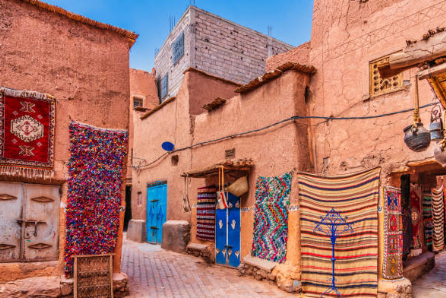If you’re planning a trip to Morocco, buying a Moroccan rug in Marrakech is likely at the top of your must-do list. These handwoven masterpieces are more than just decor—they carry centuries of history, culture, and craftsmanship. But navigating the bustling souks and negotiating with savvy sellers can be overwhelming. Here are 7 essential tips to help you find the perfect Moroccan rug and make your shopping experience enjoyable and informed.

1. Understand the Different Types of Moroccan Rugs
Before heading to the souks, familiarize yourself with the various types of Moroccan rugs. Each region has its own style, pattern, and technique, making every rug unique in its own way.
| Rug Type | Region | Characteristics | Common Colors |
|---|---|---|---|
| Beni Ourain | Middle Atlas | Thick, fluffy wool; minimalist, geometric | Cream, black |
| Azilal | High Atlas | Thinner, vibrant, abstract patterns | Red, pink, yellow |
| Boujad | Haouz region | Rich colors, tribal designs | Red, purple, orange |
| Kilim (Hanbel) | Various regions | Flat-woven, lightweight, versatile | Earth tones |
Knowing what you’re looking at can help you better appreciate the rug and ensure you’re paying a fair price. Each type of Moroccan rug has its own history and cultural significance, and understanding these differences can also aid in making a more informed decision that suits your personal taste and home decor.
2. Set a Budget (and Stick to It)
Moroccan rugs vary greatly in price, depending on the size, age, material, and craftsmanship. While a smaller Kilim may cost under $100, a large, high-quality Beni Ourain could set you back several hundred dollars or more. It’s easy to get swept away by the beauty and sales pitches, so set a realistic budget before you go shopping. Don’t forget to factor in shipping costs if you’re planning to send it home.
Keep in mind that handmade Moroccan rugs are works of art, and pricing can reflect not only the materials but also the countless hours spent creating each piece. However, knowing your financial limit will help you stay focused and avoid overspending.
3. Learn the Art of Bargaining
Bargaining is not only expected in Marrakech—it’s a cultural norm. Most rug sellers will start with a price significantly higher than what they expect to get. Be polite but firm, and don’t be afraid to walk away. Often, this will encourage the seller to lower the price.
Negotiating can feel awkward for some tourists, but it’s an essential part of the shopping experience. Begin with an offer that is 30-50% lower than the asking price and work your way up. Sellers expect a little back-and-forth and may even enjoy the friendly haggling.
4. Inspect the Quality Carefully
Look at the back of the rug. A high-quality Moroccan rug will show clear, tight knots and a consistent weave. Run your hand over the surface to feel the texture. Natural wool should feel soft but resilient. If the colors look too vivid or artificial, ask if synthetic dyes were used.
The best Moroccan rugs are made from 100% sheep’s wool and dyed with natural pigments. These rugs age gracefully and become softer over time. Also, check for any damage, moth holes, or excessive wear if you’re considering a vintage piece.
5. Ask for the Story Behind the Rug
Each Moroccan rug has a story. Many are handmade by Berber women who incorporate personal symbols, family history, and regional traditions into their designs. Asking the seller about the rug’s origin adds value and creates a deeper connection to your purchase.
These narratives often reflect the emotions and everyday lives of the women who made them, turning each rug into a piece of living history. Understanding the symbolism in the patterns can make your rug feel even more special and meaningful.
6. Consider the Size and Space
Before buying, think about where you want to place your Moroccan rug. Measure your space and bring those dimensions with you. Many buyers fall in love with a rug only to realize later that it’s too small or too large for their intended space.
Also, consider the placement—rugs for high-traffic areas like hallways may benefit from a tighter weave, while a plush Beni Ourain can add luxury and comfort to a bedroom or living room. Be sure the colors and design harmonize with the rest of your decor.
7. Get a Certificate of Authenticity
To ensure you’re buying a genuine handmade Moroccan rug, ask the seller for a certificate of authenticity. This can also help if you’re bringing the rug through customs or need proof of value for shipping insurance.
Many reputable dealers in Marrakech are happy to provide paperwork that certifies the rug’s origin, materials, and production method. While not all sellers offer this, asking for it shows that you’re a serious buyer and helps discourage counterfeits.
Buying a Moroccan rug in Marrakech can be one of the most rewarding experiences of your trip—if done right. With these 7 tips in mind, you’ll be better equipped to navigate the markets, negotiate confidently, and take home a beautiful piece of Moroccan culture that lasts a lifetime.
So whether you’re drawn to the minimalist charm of a Beni Ourain or the vibrant hues of an Azilal, remember that every Moroccan rug is more than a floor covering—it’s a handcrafted narrative woven from tradition, passion, and artistic expression.
If you’re curious to dive deeper into what makes a rug truly authentic and learn how to distinguish genuine vintage pieces from imitations, be sure to check out our article: “How to Identify an Authentic Vintage Moroccan Rug: Explore the Unique Types of Moroccan Rugs.“ It’s the perfect complement to this guide and will give you even more insight into Morocco’s rich textile heritage.
